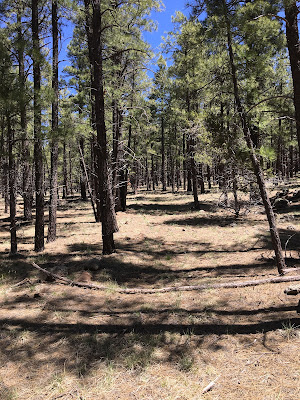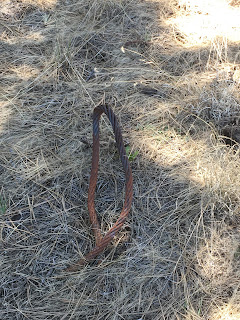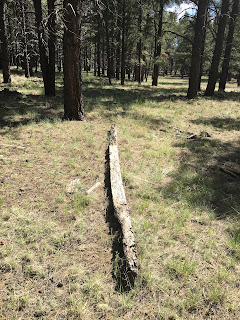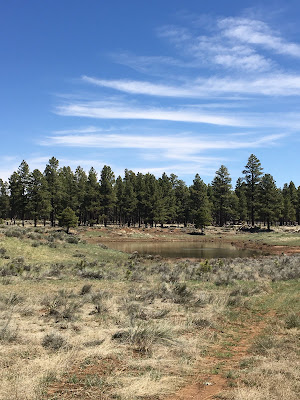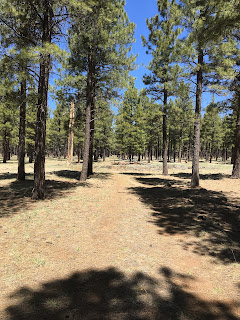SAGINAW AND MANISTEE, BELLEMONT LINE: NORTH OF KENDRICK PEAK, PART 1
(KENDRICK NORTH: EAST BRANCH)
COPYRIGHT, ALL RIGHTS RESERVED
MAPS COURTESY OF GOOGLE MAPS (REGISTERED TRADEMARK)
This post begins a multi-part series on the Saginaw's Bellemont Line, North of Kendrick Mountain. To simplify understanding, and avoid a very long title sequence, this series will henceforth be entitled either Kendrick North: West Branch, or Kendrick North: East Branch. If you have a forest map handy, these two branches split from the main Bellemont line near North West Tank, at Cowley Park. This area is on private property, and is beginning to be built up. Some of the lines in this area can be seen from the road or accessed by forest roads.
The west branch generally follows a northerly heading, passing along the base of the peak, past Crater Spring Tank and Crater Lake. The line becomes FR760, looping to the West of Horseshoe Hill, then intersects with FR191C (which is accessible from Highway 180.) FR 760 continues North, intersecting with FR90. More on this area on a later part of this series.
The east branch is a bit more challenging to find. The line at Cowley Park is difficult to follow, due to private property and closed roads. At Mudersbach Intersection, the line continues north-easterly along remote roads, eventually intersecting Highway 180 at FR191C. It then continues north along FR9007, until ending somewhere in the wilds of Arizona. This branch includes the Kendrick Park spur, the Curley Seep Tank spur, and others on the east side of Highway 180. Prior blog posts describe this area in more detail.
There is a branch spur that passes through Curley Seep, on a northerly direction. A forest road covers sections of the roadbed and may be closed to motorized vehicles. I chose to park at the tank and walk the spur. I came out into the forest to get exercise and do research, not sit in the convenience of a vehicle. We should reconsider driving about in a quad vehicle, and rely more on walking in the wilderness. Coordinates given are for reference only, and should be varified by anyone accessing this area.
This map provides an overview of the three spurs or lines that will be covered in this series. The area is relatively vast, covering many acres. The roads are rough, and not soon to be repaired so be prepared; drive a 4x4. Bring adequate water and supplies- I cannot emphasize this enough.
The spur or line that is the topic of Parts 1 and 2. Part 1 will bring us from Curley Seep Tank to where the spur intersects with FR9002F.
Curley Seep Tank, looking Northeast towards Highway 180. There is no direct access from the highway to the tank, and DO NOT park on the highway and hop the fence. You can cause an accident or be towed. The cut in the tank berm for the logging spur can be seen on the left of the picture.
A post in the ground helps to locate the general location of the spur/road.
Looking back towards the tank, the grade on the right of the image.
Decaying log and stump left by the early loggers.
The roadbed makes several turns. Just stay with the road, until you notice a rock fill ramp.
The ramp slops down. Just at the bottom you will see the grade turn to the left, leaving the road.
A berm will be noticable, where the grade was built up to cross a small creek (35.46013 N, 111.78803W.)
The raised area has several noticable features, including rock fill and an occasional tie.
Crossing the fill, the grade will continue until it enters an open park-like area.
The area is rather scenic, so stop and enjoy the view.
Looking towards the Kachina and San Francisco Peaks.
The line will cross an open area, so keep a eye out for the grade. It is almost invisible at this point.
At the point where the grade intersects FR9002F (35.45768 N, 111.79329 W.)
Part Two continues from this point. This road is accessible from the North. South of this point it is basically a quad road, or a very small 4x4.


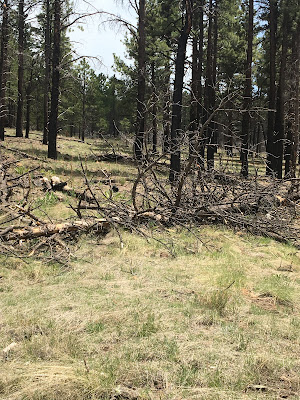



.JPG)
.JPG)

.JPG)

.JPG)
.JPG)
.JPG)
.JPG)
.JPG)
.JPG)
.JPG)
.JPG)





